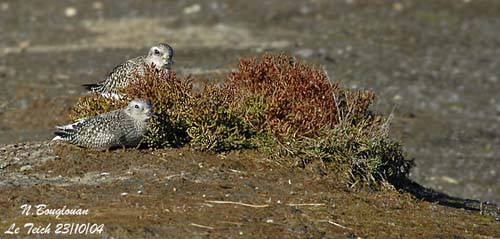
Grey Plover
Pluvialis squatarola
Charadriiforme Order – Charadriidae Family
BIOMETRICS:
Length: 27-31 cm
Wingspan: 56-63 cm
Weight: 174-320 g
LONGEVITY: Up to 20 years
DESCRIPTION :
Grey Plover is also named Black-bellied Plover.
The black axillaries only visible in flight, allow identifying this bird outside breeding season. Grey Plover is the largest of these birds. It is greyer and chunkier than other plovers. Large head and strong bill also add other differences.
It is the only one to have a rear toe on the legs.
Fr : Pluvier argenté
All: Kiebitzregenpfeifer
Esp: Chorlito Gris
Ital: Pivieressa
Nd: Zilverplevier
Russe: Тулес
Sd: Kustpipare
Photographers:
Bob Moul
Nature Photography
Tom Grey
Tom Grey's Bird Pictures
Tom Merigan
Tom Merigan’s Photo Galleries
Steve Garvie
RAINBIRDER Photo galleries
Other pictures and text by Nicole Bouglouan
Sources :
HANDBOOK OF THE BIRDS OF THE WORLD Volume 3 by Josep del Hoyo-Andrew Elliott-Jordi Sargatal - Lynx Edicions - ISBN : 8487334202
SHOREBIRDS by Peter Hayman, John Marchant and Tony Prater – Christopher Helm – 1986 – ISBN: 0747014035
GUIDE DES LIMICOLES de D. Taylor - Delachaux et Niestlé - ISBN : 2603014080

Adult male in breeding plumage has spotted silvery-white and dark grey upperparts. We can see a conspicuous white band extending from forehead, crown, nape and down neck to the breast sides. Rump and uppertail coverts are white. Tail is barred with dark grey spots.
On the upperwing, primary coverts and primary and secondary flight feathers are blackish, and we can see a white wing bar across the primaries.
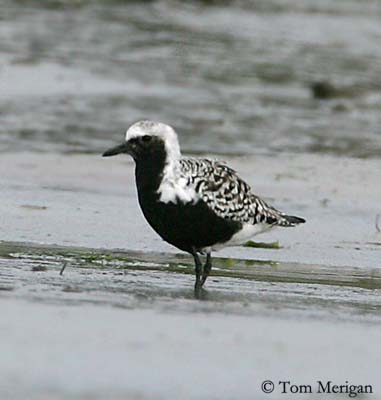
Underparts are black and join the black axillaries. Lower belly, vent and undertail coverts are white. Underwing is white with dark grey greater primary coverts.
On the head, face, chin, cheeks and sides are black. White crown is finely spotted black. Forehead and nape are white.
Black bill is strong and straight. Eyes are dark brown. Legs and feet are blackish.
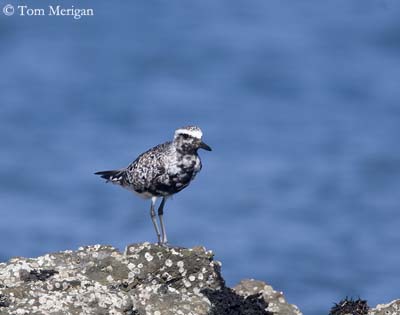
Adult female in breeding plumage has the same black parts, but spotted white and duller.
Outside breeding season, Grey Plover is speckled blackish-brown above, with golden-brown and whitish small streaks. It lacks the typical black underparts.
Face is whitish with faint white streak above the eye. Chin and throat are white. White breast is streaked greyish-brown. Bill and legs are black.
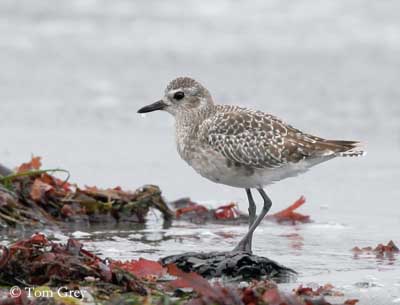
Juvenile resemble non-breeding adult, but it has darker upperparts with yellowish spots. Breast and flanks show indistinct streaks.
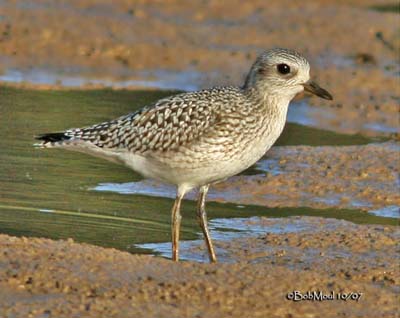
VOICE: SOUNDS BY XENO-CANTO
Grey Plover utters melancholy, long and flat song.
Usual call is loud and far-carrying. It is a whistle made of three notes “tlee-oo-ee”, with lower second notes.
On breeding grounds, we can hear a triple whistle.

HABITAT:
Grey Plover breeds in polar deserts and tundra with some vegetation such as sedges, moss and lichens, and mainly in subzone tundra.
It winters in the entire world along the coasts, mudflats, lagoons, salt marshes, beaches and meadows.
During the migration, it may frequent inland waters.
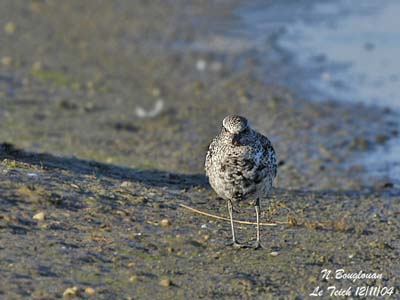
RANGE:
Grey Plover breeds in Arctic coasts, and winters along the coasts of North and South America, Western Europe, Africa, Southern Asia, Indonesia and Australia.
BEHAVIOUR:
Grey Plover feeds by gleaning food on the ground, usually on wet sandy shores. It also searches for preys under the surface. It runs and stops, in order to peck on the ground or at water surface. These birds feed in loose groups. It also may feed by night.
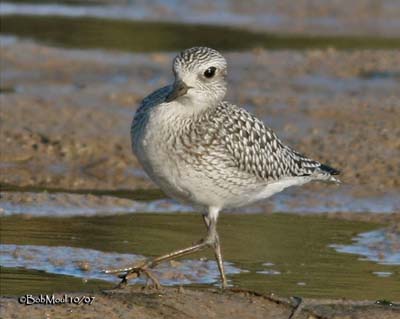
During the winter, they defend strongly their feeding areas. This behaviour starts after the breeding season, which explains why some birds seen during the migrations may be aggressive and other not at all.
The lack of vigilance of this species is well-known, and it is precisely that which prevented the Grey Plovers to experience hunting’s fear. Because the plovers fly quickly and in small groups, it is difficult to shoot!
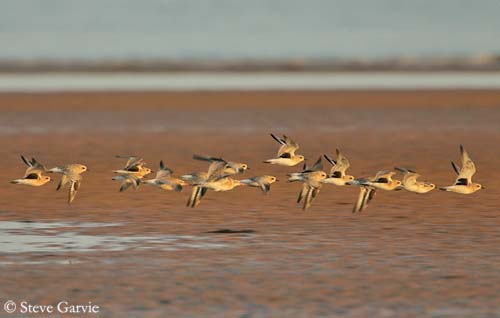
It is true also that this species is currently changing its stopovers in order to avoid the hunters.
Grey Plover performs aerial displays, a butterfly-like flight with shallow wing beats, with horizontal wings.
It joins mixed groups at large roost at night.
Grey Plover is strongly migratory and travels long distances.
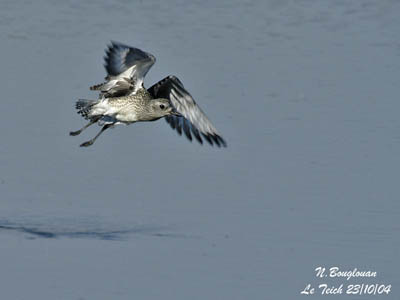
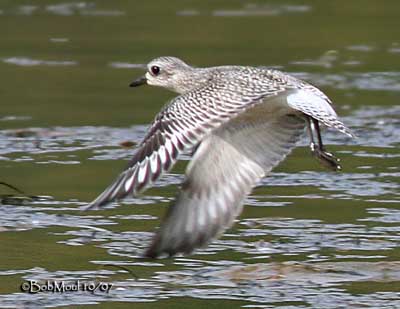
FLIGHT:
Grey Plover performs powerful and fast flight. These birds fly in loose groups, in irregular-line formation.
REPRODUCTION:
Breeding season occurs in spring, with laying from May to mid-June.
Grey Plover is monogamous and solitary nester. The nest is built by the female. It is a scrape on the ground, lined with pebbles, moss and lichens.

She lays 4 eggs with strong shell. Eggs may be pink, green or brow, with blackish or dark purple-grey markings. Incubation lasts about 26-27 days, shared by both adults, but male takes part more than female.
Young are reared in wet areas by both parents during 2-3 weeks. They fledge at about 23 days of age.
This species produces only one brood, but this clutch will be replaced is destroyed.

DIET:
Grey Plover usually feeds on insects, but also earth worms, and occasionally seeds and stems.
During migration, it feeds on aquatic worms, molluscs and other small invertebrates.
Young are fed as adults.

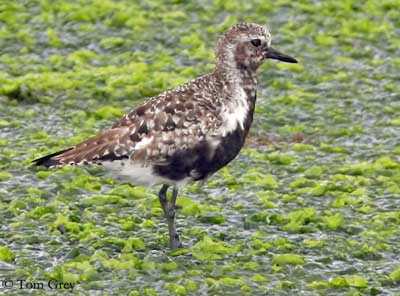
PROTECTION / THREATS / STATUS:
Young can be preyed upon by nocturnal raptors, falcons and hawks.
The spring storms involve the lost of numerous birds during the migrations.
However, Grey Plover’s populations are not threatened at this moment.
